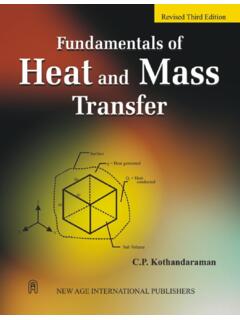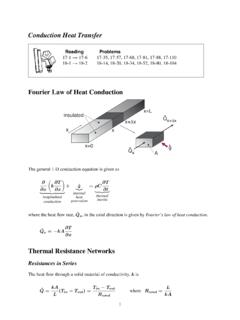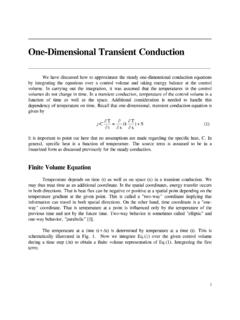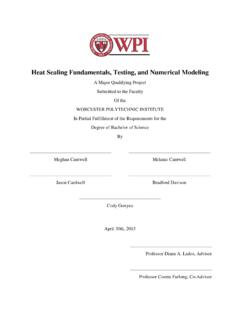Transcription of Measurements of Ground Temperature at Various Depths
1 Measurements of Ground Temperature at Various Depths Georgios Florides and Soteris Kalogirou Higher Technical Institute, P. O. Box 20423, Nicosia 2152, Cyprus, Tel. +357-22-406454, Fax. +357-22-406480 Email: (G. Florides), (S. Kalogirou) ABSTRACT: Information on Ground temperatures is necessary for many construction projects. These include the calculations of heat losses of buildings to the Ground and the design of thermal energy storage equipment. With the growing need for conservation of energy, information on Ground Temperature is also important for the possible use of the Ground as a source for heat pump applications. Engineers and architects concerned with these problems require knowledge of the factors that determine Ground temperatures as well as an understanding of how these temperatures vary with time and depth from the surface.
2 The earth Temperature beyond a depth of 1 meter is usually insensitive to the diurnal cycle of air Temperature and solar radiation and the annual fluctuation of the earth Temperature extends to a depth of 9 to 12 meters. This study discusses the factors affecting Ground Temperature and the winter Temperature variation with depth. Temperatures were measured in Nicosia, Cyprus, with thermocouples inserted in the Ground at a depth of 0m to 50m. It was found that the short-period Temperature variations in winter, are prominent to a depth of approximately The Temperature Measurements are compared to the calculated values resulting from the use of the Kasuda formula adopted by the TRNSYS type 501, with the results showing good agreement within about C for a depth greater than 2 meters.
3 Keywords: Ground Temperature , Kasuda formula, TRNSYS 1. INTRODUCTION Measurements show that the Ground Temperature below a certain depth remains relatively constant throughout the year. This is due to the fact that because of the high thermal inertia of the soil the Temperature fluctuations at the surface of the Ground are diminished as the depth of the Ground increases. Also, there is a time lag between the Temperature fluctuations at the surface and in the Ground . Therefore, at a sufficient depth, the Ground Temperature is always higher than that of the outside air in winter and is lower in summer.
4 This difference in Temperature can be utilised as a preheating means in winter and pre-cooling in summer by operating an earth heat exchanger. Also, because of the higher efficiency of a heat pump than conventional natural gas or oil heating systems, a heat pump may be used in winter to extract heat from the relatively warm Ground and pump it into the conditioned space. In summer, the process may be reversed and the heat pump may extract heat from the conditioned space and send it out to an earth heat exchanger that warms the relatively cool Ground . This study presents the temperatures measured in a borehole in Nicosia, Cyprus, during the months of December 2003 to March of 2004 in an ongoing project and compares these values with the calculated ones using the Kasuda formula.
5 2. Ground THERMAL BEHAVIOUR The use of direct or indirect earth-coupling techniques for buildings and agricultural greenhouses requires knowledge of the Ground Temperature profile. The ambient climatic conditions affect the Temperature profile below the Ground surface (Fig. 1) and need to be considered when designing a Ground heat exchanger. Actually the Ground Temperature distribution is affected by the structure and physical properties of the Ground , the Ground surface cover ( bare Ground , lawn, snow etc), the climate interaction ( boundary conditions) determined by air Temperature , wind, solar radiation, air humidity and rainfall.
6 The above daily variations can affect the Ground Temperature to a depth of approximately one meter. According to the ASHRAE Handbook of HVAC Applications [1], the earth Temperature beyond a depth of 1 meter is usually insensitive to the diurnal cycle of air Temperature and solar radiation and the annual fluctuation of the earth Temperature extends to a depth of 9 to 12 meters. In deeper layers, the Temperature distribution remains unchanged throughout the year with the Temperature increasing with depth by an average gradient of about 30 C/km. The geothermal gradient deviations from the average value are, in part, related to the type of rocks present in each section.
7 Figure 1: Energy flows in Ground . heat flow, which is a measure of the amount of thermal energy coming out of the earth, is calculated by multiplying the geothermal gradient by the thermal conductivity. Each rock type has a different thermal conductivity, which is a measure of the ability of a material to conduct heat . Rocks that are rich in quartz, like sandstone, have a high thermal conductivity, indicating that heat readily passes through them. Rocks that are rich in clay or organic material, like shale and coal, have low thermal conductivity, meaning that heat passes less readily through these layers.
8 If the heat flow is constant throughout a drill hole ( , water is not flowing up or down the hole), then it stands to reason that low-conductivity shale layers will have a higher geothermal gradient compared to high-conductivity sandstone layers [2]. A complete model for the prediction of the daily and annual variation of Ground surface Temperature is presented by Mihalakakou et al. [3]. This model uses a transient heat conduction differential equation and an energy balance equation at the Ground surface to predict the Ground surface Temperature . The energy balance equation involves the convective energy exchange between air and soil, the solar radiation absorbed by the Ground surface, the latent heat flux due to evaporation at the Ground surface as well as the long-wave radiation.
9 The model is validated against 10 years of hourly measured temperatures for bare and short-grass covered soil in Athens and Dublin. The results are compared with the corresponding results of models using Fourier analysis. Furthermore, a sensitivity investigation is performed to investigate the influence of Various factors involved in the energy balance equation at the Ground surface on the soil Temperature profile. As it is demonstrated, an increase of the wind speed leads to a reduction of the Ground surface Temperature , mainly caused by the heat transfer by convection between the Ground surface and the air and also by the latent heat flux due to evaporation.
10 An increase of the soil absorptivity leads to higher Ground surface temperatures. Also, an increase of the air relative humidity results in increased Ground surface temperatures. Popiel et al. [4], present the Temperature distributions measured in the Ground for the period between summer 1999 to spring 2001. The investigation was carried out in Poznan, Poland, for two differently covered Ground surfaces, a bare surface and a surface covered with short grass. Temperatures were measured with thermocouples distributed in the Ground at a depth from 0 to 7 m (bare surface) and from 0 to 17 m (short grass).







